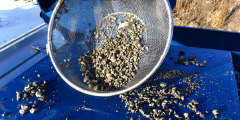Well Requirements

A. Geological /
Geophysical
1. Rock type, rock analysis, sample of rock for destructive testing is desirable.
2. Hydrocarbon analysis, including viscosity, sour chemicals, scale, asphaltenes, paraffins.
3. Water analysis, including specific conductivity and mineral, salt and trace metals content.
4. Every and all logs run on well, at any point in time in history of well, including electric / resistivity (DIL), neutron porosity / density
(CDNL), mud, oxygen, sonic, computer log, etc.
5. Temperature of target interval(s), but a temperature log is helpful.
6. Isopach map or other contour map or other seismic data interpretation (top and bottom).
7.Porosity stress matrix or tectonic stress data.
8. Initial and current reservoir pressure.
B. Engineering
Drilling
1. Drilling / daily reports or drilling summary.
2. Bit type(s), size, speed, bore hole characteristics.
3. Composition, pressure balance, pH, weight, working muds / fluids / chemicals used, etc.
4. MWD data if available.
5. LWD data if available.
6. Deviation – slope and orientation of target interval.
Cased Hole
1. Casing type, size, grade, centralizers, etc.
2. CCL (we do not like to slot through joints and this will tell us where they are).
3. Cement type, amount, mix, cement bond log if available.
Open Hole
1. Rock stability analysis if any.
2. Casing liner, gravel pack type, size, grade, centralizers, if any.
Completion
1. Treatment reports – type of treatment – perforation, stimulation details – shot, acid, frac etc.
2. Frac report details – quantities & compositions of materials, rates, pressures, times, etc.
3. Flow testing or other testing – all results, methods of testing, esp. testing by stages, if any.
4. Reports for 1 – 3 (Completion) for all subsequent re-works or re-stimulation efforts.
5. Down-hole Logistics
6. Down-hole production equipment & surface production equipment.
7. Well-bore diagram.
C. Production
Drilling
1. All records for rates, pressures – all fluids (inc. gases), on daily or weekly basis, if possible.
2. Balancing and/or overproduction status that occurred at any time.





